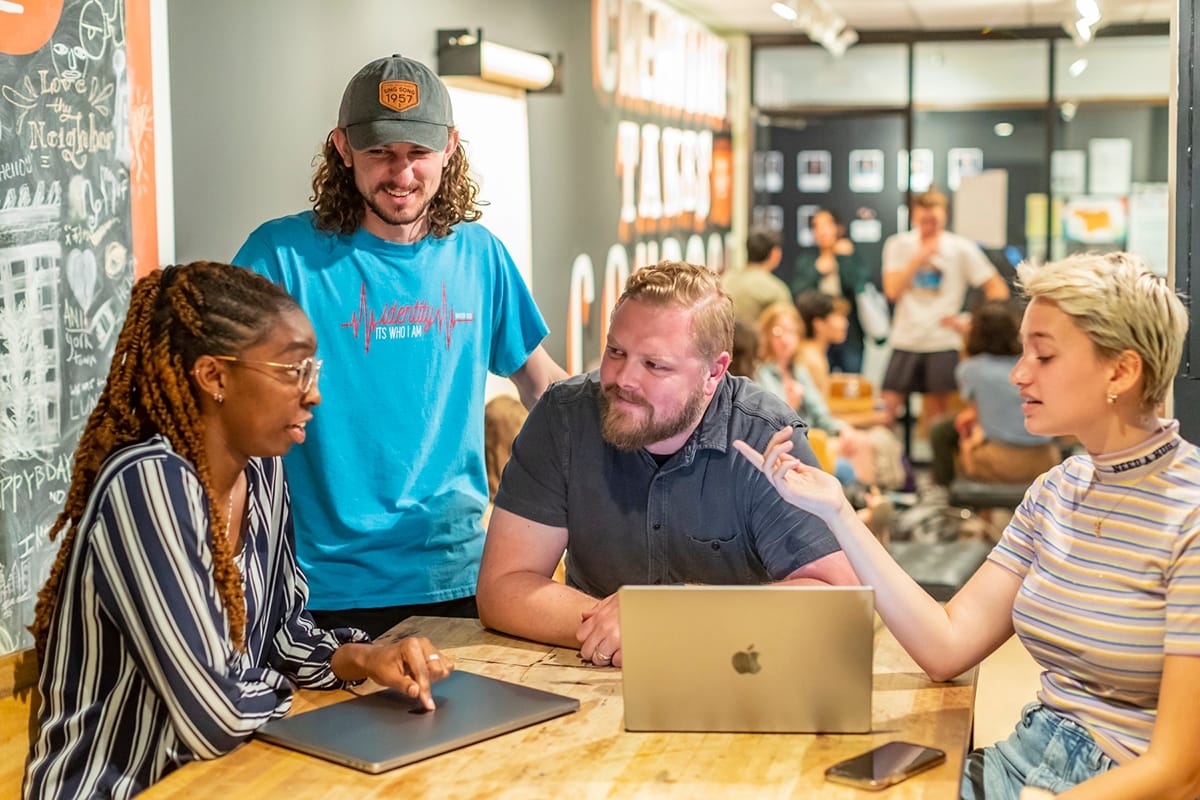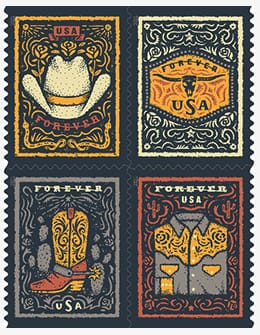Enlarge

Photo by Jeremy Enlow
ACU design professor Ryan Feerer (’05) has put his creative touch on hundreds of projects, but perhaps his most widely seen – and certainly his favorite to date – is a series of USPS Forever stamps with a western theme.
The stamp series, released in July 2021, celebrates the enduring legacy of Western wear and features iconic images of a boot, a pearl snap shirt, a belt buckle and a cowboy hat.
The project was “a designer’s dream” from a professional viewpoint, Feerer says, but it had an even more personal significance. “My grandfather passed away when I was a few months old. He was a postmaster in Logan, New Mexico, for over 20 years, and he was also a rancher. So that project meant a lot to me,” he says.
Creating the illustrations took several months and occupied much of his mental attention and time. In addition to the primary images, Feerer incorporated small plants, animals, western-inspired flourishes, the sun and other related elements to frame each clothing illustration.
“I had never created something so delicate and small. I instantly became obsessed with every detail. I tried to be strategic in the placement of every dot and stroke of each line,” he said. “This project is probably the most significant thing I will ever work on, and I wanted each stamp to live up to that.”
Enlarge

The stamp series was one in a long line of graphic design and illustration projects Feerer has undertaken. After graduating from ACU in 2005, he earned his Master of Fine Arts from the School of Visual Arts in New York City in 2007 and began work for Funny Garbage, an interactive design company there.
“I had an opportunity at the New York Times, but Funny Garbage seemed like a little more fun to me,” he says. “I got to do a lot of illustration, a lot of design work, mainly for entertainment and education clients, like Teen Nick, Nickelodeon, PBS Kids, and various museums and educational institutions.”
He then moved to the Dallas area, where he taught at a community college while working in-house at Fossil.
In 2010, he returned to teach at ACU, where he is now associate professor of design, director of the graphic design program and designer in residence for the university.
His students benefit from the wealth of professional experience he brings to his classroom, which has included designing logos, album covers and projects for brands like Fossil, Etsy, Snapchat, Academy Sports + Outdoors, and Target. Locally, he’s the artist behind the logos for many businesses, restaurants and Allen Ridge, a shopping center near ACU that is a favorite hangout for students.
His professional experience translates into special opportunities for students in ACU’s Department of Art and Design.
“We attract a special kind of student, and we have a great relationship with lots of agencies and studios,” he says. “We have a reputation. Like Fossil, for instance, will call me and say we need to hire some people. And there are a lot of ACU people working at Fossil now. That’s just one example. We constantly have people reaching out to us because the students who graduate from our program are special; they’re different.”
Feerer’s passion is to instill creative thinking into his students, and he is methodical in his process.
“The design process in my class starts off with some kind of a problem, say a local business has an outdated brand or poorly designed logo,” he says. “We have to redesign it and deliver lots of ancillary items. We always start with addressing the problem, looking at things that do and do not work, talking about why those things do or do not work. Then we start sketches, then we do critiques on the sketches – sometimes group critiques and sometimes one-on-one critiques with me. Then we do rough drafts. Then we do more critiques. And finally they present something and we critique it again.
“It’s this not-quite-endless cycle that we just keep repeating, reworking things until we get to the right solution,” he explains. “We exhaust all the bad and find things that really work. Then we do variations of the things that work until they are great.”
This process teaches students how much hard work goes into being a successful professional artist.
“Students may be discouraged at first about the quality of work they’re producing, because they are comparing it to professional work,” Feerer says. “Whether it’s graphic design or writing or whatever, it takes a lot of time and effort to be a master. Hopefully by the time they graduate they have a good understanding of what they need to know and what they need to do to be great at something.”
Students from ACU’s program not only leave with a strong understanding of principles of design but also with the skills and knowledge to put their creativity to work in a professional setting.
“We have a really high job placement within the industry – 93% of our art graduates have jobs within the industry within six months, and the percentage for graphic design students is even higher,” Feerer says. “The program is not easy, but if you work really hard you’re going to do amazing things.”
Learn more about ACU’s Department of Art and Design.
— Robin Saylor
Jan. 18, 2023
